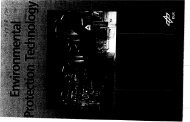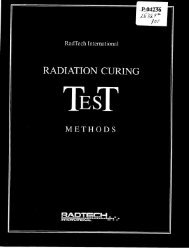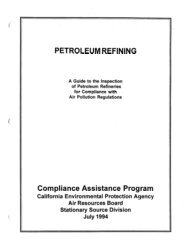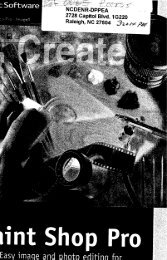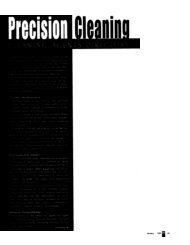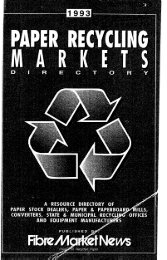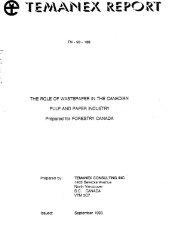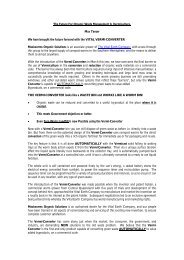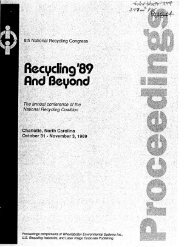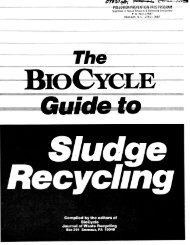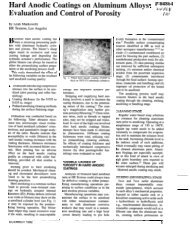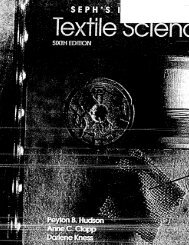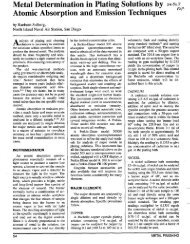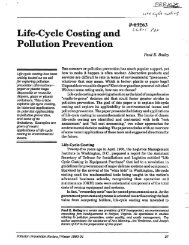Electronic Parts/Guidelines - infoHouse
Electronic Parts/Guidelines - infoHouse
Electronic Parts/Guidelines - infoHouse
You also want an ePaper? Increase the reach of your titles
YUMPU automatically turns print PDFs into web optimized ePapers that Google loves.
Alr Emlsslons: The industry ranges in the amount of blowing agents released into the air. Some man-<br />
ufacturers claim up to 90% capture and reuse, other may have up to 100% released Into the air.<br />
Hydrocarbons are heavier than air and easier to capture and reuse than HCFC, but have more harmful<br />
effects if not captured. Hydrocarbons, if not reused, can be captured and burned which reduces the<br />
by-product of creating ground level ozone. Ground level ozone Is thought to be a major contributor to<br />
global warming. Unlike hydrocarbons, HCFC creates little ground level ozone but does have a harmful<br />
effect on stratospheric ozone (approx 5% to 10% of the harmful effect of CFCs). HCFCs and CFCs<br />
are known to be responsible for the ozone depletion in the stratosphere. The depletion of ozone in the<br />
stratosphere allows more harmful radiation from the sun to penetrate the stratosphere and come in<br />
contact with the surface of the earth.<br />
Hazardous Waste: The following chemicals are commonly used in the production of PE foam:<br />
Polyethylene resin<br />
Hydrocarbons<br />
Hydrochloroflourocarbon<br />
Color additives<br />
7.5.3.3 Packaging Material Usage<br />
Transportatlot? Issues: PE foam although light Weight requires significant space to transport and<br />
should be bought from a local distributor or fabricator.<br />
Reuseblllty: PE foam products when designed properly can be reused many times. The reuse of PE<br />
foam should be encouraged.<br />
Recyclablllty: PE foam if uncontaminated can be recycled although in reality several obstacles exist.<br />
The chief obstacle to recycling is the collection process. PE foam, although produced in large<br />
volumes, ends its life in small quantities over a large geographic area. The logistics of collecting and<br />
getting the material to a manufacturer are very difficult and unrealistic. PE can be and often is recycled<br />
from the convertor level. This is generally post- industrial trim and plant scrap and represents a<br />
small percentage of US. 'PE foam production.<br />
Inclneratlon: PE foam provides 21,407 Btulpound when burned in the modern incinerator. Refer to<br />
Table 11 on page 63 for energy content of other materials.<br />
CompostabIllty/8/odegradablIlt~: PE foam is biostable and will not decompose effectively. Any<br />
attempt to enhance its degradability through starch or photodegrading agents should be avoided. This<br />
would only discourage its reuse and recycling, as these additives cause problems in recycling, and<br />
make a less durable material which would limit its reuse.<br />
7.5.3.4 Recommendations: Companies purchasing PE foam can require several things from<br />
their vendors. PE foam should contain some post consumer andlor post industrial PE content. This will<br />
increase over time with a 25% amount being a practical goal. Equally important is the manufacturers<br />
use of blowing agents While the question of HCFC vs. Hydrocarbons is open to debate, the question of<br />
recapture is not. Hydrocarbon users should capture and reuse or at least burn their off-gasing product<br />
after extrusion.<br />
By using PE foam properly in designs (efficient use, reusable, etc.) and encouraging accountability<br />
from manufacturers the packaging engineer can have a positive impact through conservation of<br />
resources and reduction of air emissions.<br />
62 Environmental Packaging <strong>Guidelines</strong>



